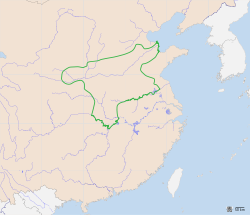Shang dynasty
| Shang dynasty | ||||||||||
| 商朝 | ||||||||||
| Kingdom | ||||||||||
|
||||||||||
|
Remnants of advanced, stratified societies dating back to the Shang period have been found in the Yellow River Valley.
|
||||||||||
| Capital | Yin (modern Anyang) | |||||||||
| Languages | Old Chinese | |||||||||
| Religion | Chinese folk religion | |||||||||
| Government | Monarchy | |||||||||
| Historical era | Bronze Age | |||||||||
| • | Established | c. 1600 BC | ||||||||
| • | Battle of Muye | c. 1046 BC | ||||||||
| Area | ||||||||||
| • | 1122 BC est. | 1,250,000 km² (482,628 sq mi) | ||||||||
|
||||||||||
| Today part of |
|
|||||||||
| Shang | |||||||||||||||||||||||||||||

"Shang" in oracle bone script (top left), bronze script (top right), seal script (bottom left), and regular (bottom right) Chinese characters
|
|||||||||||||||||||||||||||||
| Chinese | 商 | ||||||||||||||||||||||||||||
|---|---|---|---|---|---|---|---|---|---|---|---|---|---|---|---|---|---|---|---|---|---|---|---|---|---|---|---|---|---|
|
|||||||||||||||||||||||||||||
| Alternative Chinese name | |||||||||||||||||||||||||||||
| Chinese | 殷代 | ||||||||||||||||||||||||||||
| Literal meaning | Yin era | ||||||||||||||||||||||||||||
|
|||||||||||||||||||||||||||||
| Transcriptions | |
|---|---|
| Standard Mandarin | |
| Hanyu Pinyin | Shāng |
| Wade–Giles | Shang1 |
| IPA | [ʂáŋ] |
| Wu | |
| Suzhounese | Saon |
| Yue: Cantonese | |
| Yale Romanization | Sēung |
| Jyutping | Soeng1 |
| Southern Min | |
| Hokkien POJ | Siong |
| Old Chinese | |
| Baxter-Sagart | *s-tang |
| Transcriptions | |
|---|---|
| Standard Mandarin | |
| Hanyu Pinyin | Yīn dài |
| Wade–Giles | Yin tai |
| Wu | |
| Romanization | In de |
| Yue: Cantonese | |
| Yale Romanization | Yān doih |
| Jyutping | Jan1 doi6 |
| Southern Min | |
| Hokkien POJ | Ûn tāi |
| Old Chinese | |
| Baxter-Sagart | *ʔər m-traw |
The Shang dynasty (Chinese: ; pinyin: Shāng cháo) or Yin dynasty (; Yīn dài), according to traditional historiography, ruled in the Yellow River valley in the second millennium BC, succeeding the Xia dynasty and followed by the Zhou dynasty. The classic account of the Shang comes from texts such as the Book of Documents, Bamboo Annals and Records of the Grand Historian. According to the traditional chronology based on calculations made approximately 2,000 years ago by Liu Xin, the Shang ruled from 1766 to 1122 BC, but according to the chronology based upon the "current text" of Bamboo Annals, they ruled from 1556 to 1046 BC. The Xia–Shang–Zhou Chronology Project dated them from c. 1600 to 1046 BC.
The Shang dynasty is the earliest dynasty of traditional Chinese history supported by archaeological evidence. Excavation at the Ruins of Yin (near modern-day Anyang), which has been identified as the last Shang capital, uncovered eleven major royal tombs and the foundations of palaces and ritual sites, containing weapons of war and remains from both animal and human sacrifices. Tens of thousands of bronze, jade, stone, bone, and ceramic artifacts have been found.
The Anyang site has yielded the earliest known body of Chinese writing, mostly divinations inscribed on oracle bones – turtle shells, ox scapulae, or other bones. More than 20,000 were discovered in the initial scientific excavations during the 1920s and 1930s, and over four times as many have been found since. The inscriptions provide critical insight into many topics from the politics, economy, and religious practices to the art and medicine of this early stage of Chinese civilization.
...
Wikipedia

